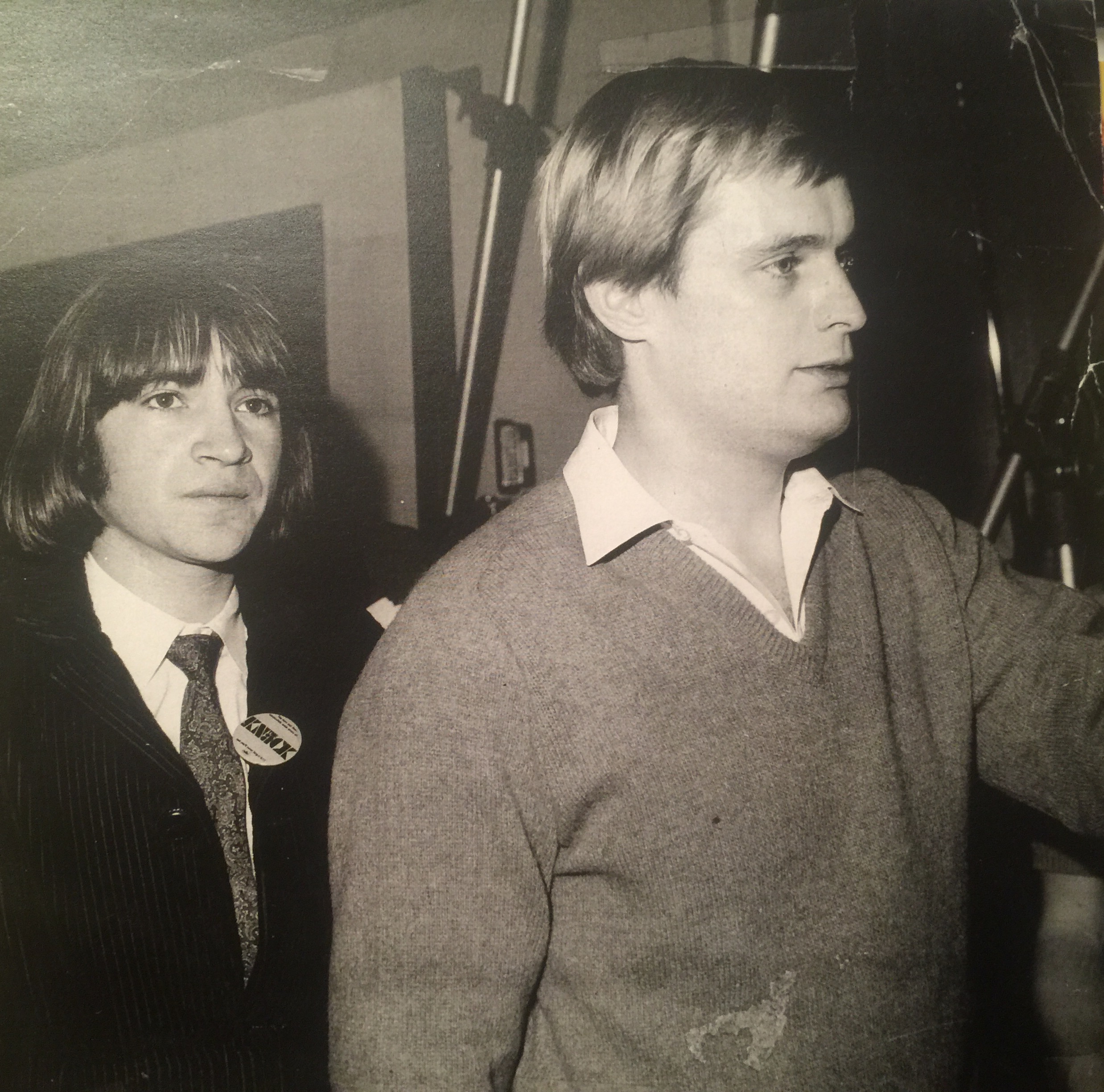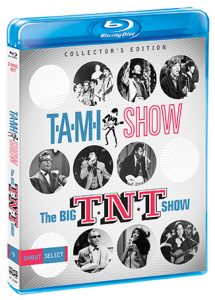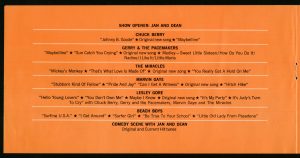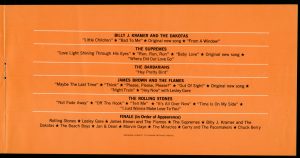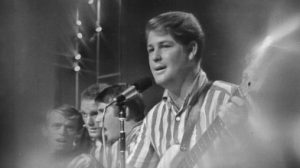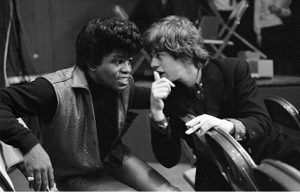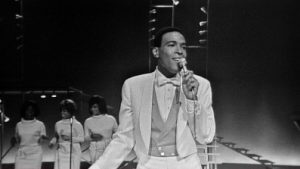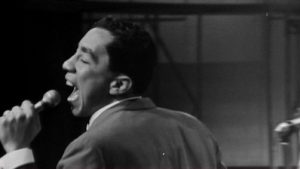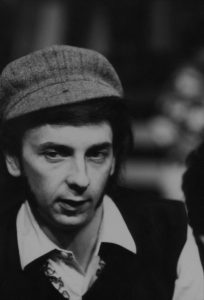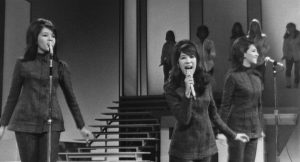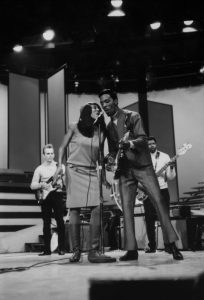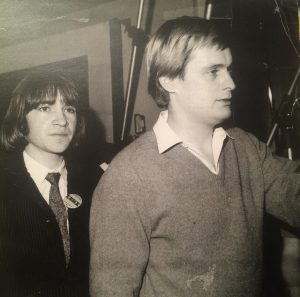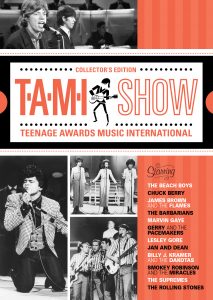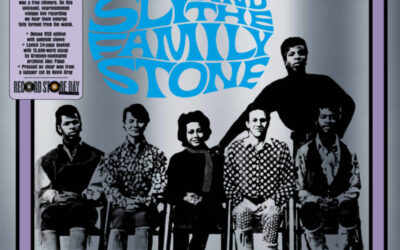By Harvey Kubernik c 2016
Fans of classic rock and soul rejoiced when the legendary concert Steve Binder-directed film T.A.M.I. Show made its DVD debut on Shout! Factory in 2009.
Now that landmark film made its Blu-ray debut, along with its long-lost—and much requested—follow-up, The Big
TNT Show, directed by Larry Peerce, on December 2, 2016, as part of the 2-disc Blu-ray set T.A.M.I. Show / The Big T.N.T. Show Collector’s Edition, from Shout! Factory. The Big T.N.T. Show was also released as a standalone DVD on the same day.
The package contains all the bonus features from the T.A.M.I. Show DVD, plus new interviews with The Big T.N.T. Show performers Petula Clark, Henry Diltz and John Sebastian. The product is mastered from a High-Definition transfer.
The Big T.N.T. Show was filmed in Hollywood on Sunset Blvd. on November 29, 1965 and stars some of the biggest acts of the day, including the Byrds, in their original line-up of Gene Clark, David Crosby, Chris Hillman, Michael Clarke, and Roger McGuinn, perform two # 1 hits, “Mr. Tambourine Man” and “Turn! Turn! Turn! (To Everything There Is A Season.”)
One of the most acclaimed rock events ever captured on film, the 1964 concert known as T.A.M.I. Show [Teenage Awards Music International] presented a lineup like no other, the Rolling Stones, James Brown, the Beach Boys, Marvin Gaye, the Miracles, the Supremes, Chuck Berry, Lesley Gore and other acts took the stage one after another rehearsed and recorded over two days and nights on October 29 and 30th on Pico Blvd. at the Santa Monica Civic Auditorium. Marshall Berle, Howard Wolf, John Landis and David Cassidy were in the audience.
I was literally across the street, with my surfer pal Peter Piper during one afternoon at the Con Surf Board shop and too busy buying paraffin wax for my skateboard to even realize what was happening inside that venue.
Aside from the five rock groups, all the performers were backed by a band assembled by musical director Jack Nitzsche. Including Hal Blaine, Glen Campbell, Tommy Tedesco, Don Peake, Barney Kessel, and Leon Russell, along with Fanita James, Jean King, and future solo star Darlene Love, billed as the Blossoms, provided backing vocals.
Director Steve Binder, a native of Los Angeles, departed the University of Southern California just before graduating to apprentice under host Steve Allen, who pioneered a variety show.
Binder, barely in his twenties, then took on Jazz Scene USA, bringing live performances by musical masters to a
network audience. Binder understood the unique requirements of lighting and blocking for musicians in an optimal setting. Once The T.A.M.I. Show was screened theatrically in 1965, the flick informed every subsequent rock concert movie.
“Going back to Steve Allen and Hullabaloo where I was collecting people all the way through my career that I wanted to have in my team and work together with,” Binder explained to me in a 2008 interview.
“And in those days, technically, union wise, you unless you had a union card you weren’t supposed to participate. I learned together the difference between making records and television audio. It was a perfect marriage. Even in lighting I would bring in rock ‘n’ roll guys who did concerts with guys bred on television and movies. All of a sudden they were learning about the contemporary music business.”
Binder would go on to direct many music TV specials, including the seismic Elvis: The ’68 Comeback Special.
“I met the Stones in 1964,” Jack Nitzsche told me in a 1988 interview. “Andrew Loog Oldham called me up. He and the group had met Phil Spector and Andrew and the Stones wanted to meet me. Brian Jones was in a three piece suit and tie. It was at RCA studios and I was working with Edna Wright, Darlene Love’s sister.
“A little later, the Stones started working at RCA.
“I got them into The T.A.M.I. Show. I put the band together and did all the arrangements. I was the musical director. I had told the producer, Bill Sargent, the Stones were going to be big. I felt the Stones could close the show.
“Bill said ‘James Brown is going to close the show.’ We all stood at the side of the stage watching James Brown do
his act. People were standing and screaming for James. (Legend has it that James told the Stones, ‘you’ll never be able to follow this.’). Then the Stones came out and all the girls started crying. It was a whole new emotion!
“I put Leon Russell in The T.A.M.I. Show band. He’s all over the soundtrack. I met him with Jackie DeShannon; she introduced me,” Jack Nitzsche explained to me in our interview.
“Leon at the time was playing piano in a bar in Covina. He was an innovative piano player. He was good. I heard him on a Jackie DeShannon record. In those days it was real hard to find rock ‘n’ roll piano players who didn’t play too much. Leon talked the same language.
“I had met Don Randi a long time ago. He was a pianist at a jazz club on La Cienega,” recalled Nitzsche in our conversation. “He was cool. He looked like a beatnik. His hair was right. He had the attitude. He didn’t smile when he played.”
“In a stunningly monochromatic case of Life imitating Art imitating Pop and Soul. The TAMI Show is the living, beating, in-the-flesh reincarnation of all those cavalcades of stars Alan Freed would assemble during the closing reels of most each and every Fifties B-flick beginning with the word ‘Rock.’ Indeed, in TAMI we can still see Gerry Marsden in a guitar duet to the death with none other than Chuck Berry, Mick Jagger wisely conceding to take on the blue-flaming Butane James Brown, the Barbarians’ five-fingered drummist practically inventing Garage Rock, Marvin Gaye hitch-hiking after Diana Ross’ supreme eyeful, and to top it all – to HOST it all, no less – those Clown Princes of Surf ‘n’ Roll themselves, Jan and Dean!
“Steve Binder recorded absolute history with this screaming little film; even the briefest glance towards Dennis Wilson’s moptop during ‘Surfin’ USA’ will tell you why,” is how music journalist Gary Pig Gold described the legendary sight and sound collaboration in 2005
In 2004 I interviewed Andrew Loog Oldham, the manager/producer and publicist for the Rolling Stones, and I asked him about The T.A.M.I. Show.
“Why it works for me is the fear and loathing in Santa Monica There you go. Come on man, it’s a magic moment.
“Seeing the Motown acts was terrific. Seeing Jack Nitzsche and Dave Hassinger. It was the film within the film. ‘Isn’t
it nice to be in this business? Everyone is working together for one thing. The Beach Boys’ shirts were horrendous. Isn’t it nice we’re all here?’ The Stones were becoming successful, and getting good, and wait a minute, we gotta follow James Brown?
“Bill Sargent did The T.A.M.I Show and the black and Electronovision Harlow with actress Carol Linley.”
In the early sixties, engineer Sargent with Joseph E. Bluth developed an electronic camera system with better resolution than traditional television cameras known as Electronovision technology. Bluth served as technical director on the Los Angeles television station KTTV 1950-1951 TV series, The Buster Keaton Show.
In November of 1974 for Melody Maker, I interviewed Bobby Rogers, a founding member of the Miracles with his sister Claudette Rogers, Ronnie White, Pete Moore, and William “Smokey” Robinson.
“I really loved touring with the English groups, back in 1963 and 1964. We used to tour with the Rolling Stones and people like Georgie Fame. During the breaks from touring, a lot of the groups would ask questions about certain songs on our albums. I remember when we filmed The TAMI Show, Mick Jagger would ask me about what I’d thought of the album James Brown Live At The Apollo, which was his favorite LP. One time on a tour he mentioned that he’d like to record a Marvin Gaye song for the next Stones album. A month later, ‘Hitch Hike’ was being played all over Detroit radio,” marveled Rogers.
In According to the Rolling Stones, published by Chronicle Books in 2003, Keith Richards remembered The T.A.M.I. Show as “really kaleidoscope. It had never been done before, and it’s never been done since.”
In a 2001 interview I had with Bill Wyman, I asked him about The T.A.M.I. Show and the stage presence of the Rolling Stones. “The band was great live always. Always. The Stones were a better live band than any other band at that time. I’m not saying they were the greatest songwriters or the greatest recording artists, but they were the best live band wherever you went. You could go up on stage and blow everybody away no matter who they were.
“As long as me and Charlie could get it together, then the rest of the band could do what they’d like and it worked. And that’s what happened in the studio, and that’s what happened live. Me and Charlie were really always on the ball, always straight, always together and had it down.”
In 2001, I spoke with dancer Toni Basil, who helped choreograph The T.A.M.I. Show with David Winters.
“I said to myself, ‘How can anybody follow James Brown?’
“Anyway, Jack [Nitzsche] pointed this out to me, and I later heard as well, that Andrew Loog Oldham was so smart
that he staged a massive equipment breakdown as well as suggesting some camera angles. I just knew that Andrew was saying that the Stones’ equipment broke down and they had to wait for stage set up. We knew it was some time would pass after James Brown’s performance.
“So, finally, maybe the tune was ‘It’s All Over Now,’ where there is a big cymbal crash in the opening of the song and Mick had a tambourine in his hand and I wanna tell you simultaneously with that crash in the music Mick jumped up in the air, and as he jumped up in the air, Brian Jones turned his back to the audience, which was the first rebellious piece of theater I had ever seen in my entire life.
“I come from vaudeville. My parents were in vaudeville, on stage shows. You never turned your back to the audience. So, Mick was jumping in the air, Brian had his back to the audience, and Mick hit the ground in a crouch. Not one person ever remembered James Brown again. And neither did I.
“Mick’s moves were fantastic. What is this? What is he doing, ya know? As a trained dancer and even as a Go Go dancer and a street dancer, I had never seen such moves in my life. I mean, what they really were post-modern and right on the beat.
“It doesn’t matter what physically you’re doing as long as you’re grabbing the beat. But Mick was doing physical moves that no one had ever seen before. In the same way James Brown was doing physical moves that no one had ever seen before. And Brian [Jones] had his back to the audience for a lot of the set. He was a rebellious comet and hardly turned around which made it extremely powerful. It helped this rebellious theater. I really did.
“If Brian would have faced front, it would be great, and Mick would have been great but there was a theatrical ambience that Brian brought because he turned his back. And the Stones didn’t take a bow, which I thought was
shocking. I mean, even James Brown came on and took a bow.
“Elvis Presley, James Brown and Mick Jagger had some similarities regarding dance. They moved exactly to the beat. They understood the back beat. And James of course, understood it from a Gospel sense. But Mick, even though his moves were very abstract, and they were almost like where white boys do that can’t dance to the beat, but the difference with Mick is, he did dance to the beat.
“What Elvis, James and Mick had in common was that they were nailing the beat. They were all physically dancing to the beat. They weren’t like guys who came before them like Frank Sinatra, or those people who would move to the lyric. Their movements came about from the story. Their movements didn’t come about the story. Their movements
came because of the music.
“One more thing about The TAMI Show. When Smokey Robinson and the Miracles earlier did ‘Mickey’s Monkey,’ I lost my mind. That was really something. And Jack Nitzsche was brilliant. He was the one who called the shots of what order people went in. And man, he didn’t make a mistake. How did he know he could put the Stones on after James Brown? To this day I didn’t know how he had the balls to do that and how he had an idea that it could be pulled off like it was.”
Don Randi was the musical director for The Big T.N.T. Show taped in 1965 in Hollywood that Phil Spector produced and Larry Peerce directed, who would eventually helm the feature movie Goodbye Columbus.
The Big T.N.T. Show was filmed at the Moulin Rouge in Hollywood, where portions of the Ross Hunter-produced and Douglas Sirk directed Imitation Of Life motion picture starring Lana Turner, Sandra Dee and Susan Kohner were lensed.
Many girls in my Los Angeles junior high school homeroom class were invited to the affair while the boys were encouraged not to attend.
One afternoon in 1976 at Phil Spector’s mansion in Beverly Hills while doing an interview with him for Melody Maker, I asked Phil about his monumental catalog as well as the music he produced in live settings as exemplified in The Big T.N.T. Show.
“The musicians I have never outdo me. I’m not in competition with them. I’m in complete accord with them. You need the ability so you hire the best. I have the creativity. I know what I want.
“I always thought I knew what the kids wanted to hear. They were frustrated, uptight. I would say no different from me when I was in school. I had a rebellious attitude. I was for the underdog. I was concerned that they were as misunderstood as I was.”
During The Big T.N.T. Show, Ray Charles gives a rousing performance of “What’d I Say” and “Let the Good Times Roll.” A sultry performance by The Ronettes on “Be My Baby” is met with impassioned screams from the audience; The Lovin’ Spoonful perform their Top 10 hits “Do You Believe in Magic?” and “You Didn’t Have to Be So Nice”; and Bo Diddley delights the crowd with “Bo Diddley” and “Hey, Bo Diddley.”
To close the show, The Ike & Tina Turner Revue give an electrifying recital, spotlighting “I Think It’s Going to Work Out Fine” and “A Fool in Love.”
Also on the stage that evening was Petula Clark, performing her No. 1 hit “Downtown”; Roger Miller, playing his biggest hit, “King of the Road”; Donovan, opening his set with Buffy Sainte-Marie’s “Universal Soldier”; and the reigning queen of folk, Joan Baez, reflecting the continuing popularity of the genre as the Vietnam War escalated. Phil Spector also played piano for Joan Baez’s rendition of the Righteous Brothers’ “You’ve Lost That Lovin’ Feelin’.”
Donovan would remain in Hollywood after the taping, and soon record “The Trip” and “Season of the Witch” at the Columbia studios on Sunset Blvd. later sequenced into his Sunshine Superman album.
Performing to the side of the stage in between acts, but not seen in The Big T.N.T. Show film, was the Modern Folk Quartet. Made up of songwriter/producer Chip Douglas, Lovin’ Spoonful member Jerry Yester, rock photographer Henry Diltz, and songwriter/musician Cyrus Faryar, with session player “Fast” Eddie Hoh on drums, the band closed the evening with the show’s Harry Nilsson-composed theme song “This Could Be The Night.”
To this day, it is the opening theme to the weekly DJ Rodney Bingenheimer’s Rodney on the ROQ radio shift on
KROQ-FM 106.7.
Originally billed as a companion piece to The T.A.M.I. Show after that event’s success, The Big T.N.T. Show holds up as an essential time capsule from its day.
David McCallum, a rising star appearing in the new TV series The Man From U.N.C.L.E., was tapped to emcee. Filmed at what was then the Moulin Rouge nightclub on Sunset, footage also includes shots of the Hollywood haunts Chateau Marmont, Ben Frank’s coffee shop, and fleeting hot spot The Trip nightclub.
Frank Zappa, Sky Saxon, Mary Hughes, Rodney Bingenheimer, Johnny Legend and Ron and Russell Mael [later of Sparks] are shown on screen in The Big T.N.T. Show audience.
“I went to the taping. There was an open-door policy,” volunteered Bingenheimer. “I might have gotten tickets at Wallichs Music City on Sunset and Vine.
“Phil Spector was around. Backstage there was food and all the cool bands from the Sunset Strip were there. This was the event of the sixties. In a theater with a revolving stage.
“I spent some time with David McCallum. We talked about music. His father was a classical musician in England. I was introduced to Donovan. And I sat in the middle of the audience when he sang on a stool. It was cosmic!
“The Ronettes were amazing. I loved Ray Charles. To this day, his LP, Ray Charles Sings Country and Western is one of my favorites,” he enthused.
“We were watching this mind-blowing show in color but we knew the movie from it was going to be in black and white. What was really nice about the whole thing, and this what Hollywood was like during 1965-1967, was that many of the acts at the show hung out in the lobby and talked to fans and signed every autograph. I had already seen the Beatles at the Hollywood Bowl and this event was just as incredible.
“Man, I have been waiting a long time for this official retail release.”
This sanctioned commercial Big T.N.T. Show product has been hailed as one of the definitive music flicks from the coast with the most.
“We did The Big T.N.T. Show with Phil,” offered Don Randi in a 2008 interview I conducted with him. “And, on all our dates, we all could read, except maybe a few of the guys who were brought in as players and specialists. All the guys could always read chord charts. That’s for sure. I had Barney Kessel on The Big T.N.T. Show.
“My guys in the studio could play live anywhere,” stressed Randi. “They were capable musicians. The Big T.N.T. Show was fantastic because of Phil. And he gave me the opportunity, ‘cause otherwise I could have taken another date. But when Phil calls, he was ‘first call’ for me. If I were going to do something else many times I would move things around to accommodate him.
“You’ve got to remember that most of the guys that were in ‘Phil’s band’ especially were all jazz players and rock ‘n’ roll was a living for them. And a lot of them didn’t like it as much as I did. I have to be very frank about it. I always liked the rock ’n’ roll part of it. I thought it was great fun and sometimes very musically interesting. Not all the time. 80 per cent of the time. We got to do some things on rock ‘n’ roll dates we could not do in jazz and studio settings. It’s an interesting concept but those guys were very capable. They were the best musicians and still are the best musicians,” Randi boasted.
Randi’s principal stagehand was Robert Marchese, a record producer, who later won a Grammy for producing the first live Richard Pryor comedy album from The Troubadour. Marchese previously engineered some sessions for Spector.
At the taping, Marchese observed a conversation between Spector and Ray Charles.
“Don Randi got me the gig as his assistant,” recalled Marchese. “I was setting up the stage and working with the orchestra in the pit,” Marchese relates from Pittsburgh, PA.
“The arranger/producer) Arif Mardin was there and gave me a copy of the Otis Redding album, Otis Blue. I saw Joe Adams, who was a well-known radio DJ in L.A. (The Mayor Of Melody) and an actor (Carmen Jones, among other credits).
“He was also Ray’s right hand man. I told Joe I wanted to shake hands with Ray Charles. He said ‘sure.’ I said hello to Ray, and then he motioned to Joe and me to take him to ‘meet’ Phil Spector, who was overseeing the whole ball game. The Byrds were setting up. Ray says to Phil, ‘Are you Mr. Phil Spector?’ ‘Yes.’ ‘Are you the Boy Genius?’ ‘Yes.’ ‘Are you the inventor of the Wall Of Sound?’’ ‘Yes.’ ‘Are you the guy who had over 20 hit singles in a row?’ ‘Yes’” ‘Then Mr. Spector, how come there’s no toilet paper in the bathroom?’”
“The then King-Of-All-Media-in-waiting Phil Spector not only fully launches action with the ultra Modern Folk Quartet’s ‘This Could Be The Night’ – setting composer Harry Nilsson’s career on its way in the process,” underscores writer and archivist Gary Pig Gold, “not at all coincidentally – but stuck all the way round to produce the T.N.T. to boot; glimpse his ivories right beside righteous Joan Baez f’rinstance.
“Uncle Phil also graciously allowed Ronnie out to front her fabulous Ronettes …while keeping both ears keyed onto Ike and especially Tina Turner too, you can bet.
“Meanwhile, a still freshly-flying Byrds were counseled backstage by no less than Roger Miller to stick to their countrypolitan guns, Petula Clark can be seen serenading Sky Saxon (as a somewhat dejected F. Zappa sulks elsewhere within the Moulin Rouge), and ingenious-as-ever Ray Charles adds full frug to his American International Ingredients for Soul. Dump into the gloriously mono mix Donovan, Diddley, Illya Kuryakin and a positively scene-stealing – thanks to Canucklehead-in-residence Zal Yanovsky, naturally – Lovin’ Spoonful and, lighting its stick and letting off one brash bang indeed, The Big T.N.T. Show in many ways somehow even managed to one-up its big T.A.M.I. brother!”
For further revelations and insights into both of these history-making game and frame films, bundled together on Blu-ray, I readily suggest reading Rock ‘N’ Film: Cinema’s Dance With Popular Music, a terrific book penned by Dr. David James, published in 2016 by Oxford University Press.
In addition, there is also my own 2005 title, Hollywood Shack Job Rock Music In Film and On Your Screen, published by the University of New Mexico Press.
(Harvey Kubernik has been a music journalist for over 44 years and is the author of 8 books. During 2014, Harvey’s Kubernik’s Turn Up the Radio! Rock, Pop, and Roll in Los Angeles 1956–1972 was published by Santa Monica Press.
In September 2014, Palazzo Editions published Leonard Cohen: Everybody Knows, a coffee—table—size volume written by Kubernik, currently published in six different foreign languages. BackBeat/Hal Leonard Books in the United States.
Harvey and Kenneth Kubernik wrote the text for photographer Guy Webster’s award-winning first book for Insight Editions published in November 2014. Big Shots: Rock Legends & Hollywood Icons: Through the Lens of Guy Webster. Introduction by Brian Wilson.
In March, 2014, Kubernik’s It Was 50 Years Ago Today The Beatles Invade America and Hollywood was published by Otherworld Cottage Industries.
In November of 2015, Back/Beat/Hal Leonard published Harvey’s book on Neil Young, Heart of Gold).
During 2017, Sterling will publish Harvey Kubernik’s 1967 Complete Rock Music History on the Summer of Love).

